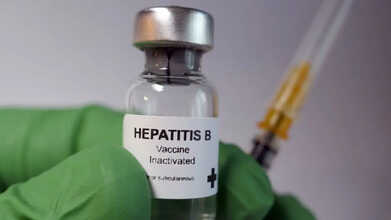- Health Conditions A-Z
- Health & Wellness
- Nutrition
- Fitness
- Health News
- Ayurveda
- Videos
- Medicine A-Z
- Parenting
- Web Stories
Leukemia Can Now Be Treated By New Immune Cell Treatment

(Credit-Canva)
Cancer is an umbrella term for abnormal excess growth that can occur in any part of the body. Leukemia is the cancer of blood, which means there is rapid growth of abnormal blood cells. This growth starts in the bone marrow, which is where your body makes blood. The Cleveland Clinic explains that unlike other cancers, leukemia does not form a mass or tumor that can be detected in a CT scan.
The usual treatment of Leukemia involves Chemotherapy, whether by pill, injection into your vein or a shot under your skin. Another treatment for it is immunotherapy which uses a drug to boost your body’ defense system so that it can fight the cancer itself. Now, a research by American Association for Cancer Research April 2025, has revealed that a pre-made version of immunotherapy can effectively fight blood cancers. This "off-the-shelf" approach offers a potentially faster and easier way to deliver this powerful therapy to patients in need.
Promising Treatment Against Blood Cancer
This new way to treat blood cancer uses special immune cells called natural killer cells, or NK cells. These NK cells have been changed in a lab to have special tools, called CARs, that help them find and kill cancer cells. What's really helpful is that these CAR NK cells can be made ahead of time from healthy people and stored. This means doctors can just take them off the shelf and give them to patients who need them quickly, without having to wait for a treatment to be made just for them, making the whole process much simpler and faster.
The results from using this ready-made CAR NK cell treatment yielded promising results, especially for people with a type of blood cancer called acute myeloid leukemia, or AML. The scientists found that after getting this treatment, some of the patients with AML had their cancer completely disappear. This is called complete remission, and it means there were no signs of cancer left in their blood. These early successes give a lot of hope for a new and better way to treat this difficult disease.
Notably, AML is a very fast-growing and serious cancer. According to American Cancer Society this cancer develops in the myeloid cell, the cells that would normally become white blood cells. This type of cancer develops quickly, hence needs to be treated with the same urgency.
Who Does This Treatment Help?
The first group of patients who received this ready-made CAR NK cell treatment were people whose leukemia had either stopped responding to other treatments or had come back after treatment. These are often the most difficult cases to treat. The fact that some of these patients had such a good response to the SENTI-202 treatment, which is a safety feature to the SENTI-202 cells. It's like a special switch that stops the NK cells from attacking healthy cells in the body. With their cancer completely disappearing, is a very encouraging sign that this new approach could offer hope to patients who have run out of other options.
More Research Needed To Confirm Safety and Effective
The researchers are hopeful about the new treatment and early success for the treatment. They believe that this ready-made approach could lead to new types of immune therapies that are much easier to produce and give to patients. Researchers emphasized that there's a big need for better treatments for AML, and he hopes this new method can become an important option for these patients who often have very limited choices.
It's important to remember that these are just the first results from an ongoing study. The scientists are still enrolling more patients to learn even more about how safe and how well SENTI-202 works. They need to keep studying it to make sure it's a reliable and effective treatment for more people with blood cancers. Before this treatment can be used widely, the findings need to be carefully reviewed and published in a scientific journal.
CDC Vaccine Panel Updates COVID-19 Guidelines: What You Need To Know

Credits: Canva
A federal panel of vaccine advisers met Friday, September 19, 2025, to discuss changes to COVID-19 vaccine access, in a session marked by technical glitches, procedural confusion, and heated debates among experts.
The Advisory Committee on Immunization Practices (ACIP) ultimately withdrew its most controversial proposal, which would have required a prescription for the vaccine. While this avoids the strictest restriction, it could still make COVID-19 vaccines less accessible than in previous years. Keep reading for detailed updates and what this could mean for you.
CDC Updates COVID-19 Vaccine Guidance: What You Need to Know
The US Centers for Disease Control and Prevention (CDC) vaccine advisers have voted to move away from a broad recommendation for COVID-19 vaccines. Under the new guidance, individuals are encouraged to make vaccination decisions through “shared clinical decision-making” with a healthcare provider.
ALSO READ: American Heart Association Updates Hypertension Guidelines: Here’s What To Know
The Advisory Committee on Immunization Practices (ACIP) was divided on whether a prescription should be required for the vaccine, with a 6-6 tie broken by committee chair Dr. Martin Kulldorff, who voted against the requirement.
According to the panel, people aged 65 and older should decide on vaccination in consultation with a doctor or healthcare provider. The same approach is recommended for those aged 6 months to 64 years, emphasising that the benefits are greatest for individuals at higher risk of severe COVID-19 and lowest for those at lower risk, based on CDC-defined risk factors.
These recommendations are not final and will be reviewed by Acting CDC Director Jim O’Neill for approval. Changes could still be made before official implementation.
Who Should Consult a Healthcare Provider Before Vaccination?
On September 19, 2025, the CDC’s Advisory Committee on Immunization Practices (ACIP) voted to discontinue its universal recommendation for COVID-19 vaccinations. Instead, the committee endorsed a "shared clinical decision-making" approach, advising individuals to consult with healthcare providers before receiving the vaccine. This decision particularly affects individuals under 65 without underlying health conditions, as they are now encouraged to make vaccination decisions in collaboration with their clinicians. This new action is important for:
High-Risk Groups
The new guidance underscores the importance of shared decision-making for individuals aged 65 and older, as well as those under 65 with underlying health conditions. For these groups, the ACIP recommends discussing the risks and benefits of vaccination with a healthcare provider. This approach aims to ensure that vaccination decisions are tailored to individual health profiles and circumstances, as per The Washington Post.
Access and Implementation
Despite the shift in recommendations, COVID-19 vaccines will remain accessible to all individuals. Major insurers have committed to continuing coverage through at least 2026. However, the change may impact access, especially for those without regular access to healthcare providers. Pharmacists, who previously administered vaccines without prescriptions, will now be limited to providing them only to individuals who have consulted with a healthcare provider.
Access and Coverage Amid the CDC Changes
A spokesperson for the U.S. Department of Health and Human Services emphasized that the move to shared clinical decision-making will not limit vaccine access. Immunization coverage will continue through all payment mechanisms, including entitlement programs like Children’s Health Insurance Program (CHIP), Medicaid, and Medicare, as well as insurance plans available via the federal Health Insurance Marketplace.
ALSO READ: CDC Advisers Postpone Vote On Newborn Hepatitis B Shot; What It Means For Your Child
This ensures that even with the shift from a universal recommendation, individuals consulting their healthcare providers can still receive COVID-19 vaccines without facing coverage barriers.
Hepatitis B Vaccine Vote Postponed
The CDC advisory committee’s COVID-19 discussions followed a turbulent start to their meeting, including a redo of earlier guidance on the MMRV (measles, mumps, rubella, and chickenpox) vaccines. A notable development was the postponement of a vote on the hepatitis B vaccine for newborns.
Advisers voted 11–1 to delay changes to the current recommendation, which involves giving babies a hepatitis B shot at birth before hospital discharge. The discussion had explored the possibility of waiting until newborns are at least a month old to receive the vaccine. a recommendation that would have marked a significant change in neonatal care protocols, as per ABC News.
American Heart Association Updates Hypertension Guidelines: Here’s What To Know

Credits: Canva
Most of us have felt our heartbeat quicken during a tense meeting or after one too many cups of coffee. Usually, we brush it aside. But for millions of people, that racing pulse signals something much more serious, high blood pressure. Often called the ‘silent killer,’ it shows few warning signs until it leads to major complications.
According to the 2025 American Heart Association Statistical Update, nearly half of U.S. adults, around 122 million people, are living with high blood pressure, a top preventable cause of heart disease, stroke, and early death. Shockingly, only about one in four have their condition under control.
With cases climbing each year, the American Heart Association has introduced new guidelines on blood pressure management. Here’s a closer look at the changes and what they could mean for you.
The New AHA-ACC Hypertension Guidelines: What You Should Know
In August 2025, the American Heart Association (AHA) and the American College of Cardiology (ACC) updated their blood pressure guidelines, with an emphasis on earlier intervention and personalized care. High blood pressure remains one of the most common and dangerous health conditions, but these updated recommendations aim to catch risks sooner and improve outcomes.
Key Updates at a Glance
- Earlier Treatment: People with a 10-year cardiovascular disease risk of 10% or more are advised to begin medication sooner, along with lifestyle changes.
- Personalized Risk Assessment: Doctors are encouraged to use the PREVENT™ calculator to estimate a person’s 10-year risk of heart attack, stroke, or heart failure.
- Expanded Lab Testing: New tests, such as the urine albumin: creatinine ratio, are now recommended to help tailor treatment.
- Lifestyle First: The guidelines reinforce limiting sodium intake to 1,500 mg per day, managing weight, and staying physically active.
- Alcohol Limits: Men should limit to two drinks a day, women to one.
Blood Pressure Categories (Unchanged Since 2017)
- Normal: <120 / <80 mm Hg
- Elevated: 120–129 / <80 mm Hg
- Stage 1 Hypertension: 130–139 / 80–89 mm Hg
- Stage 2 Hypertension: ≥140 / ≥90 mm Hg
When to Start Treatment
If you have heart disease, diabetes, or kidney disease, or your 10-year ASCVD risk is 10% or higher, treatment should begin at 130/80 mm Hg.For Stage 2 hypertension (≥140/90), doctors may recommend combination pills, including ACE inhibitors, ARBs, calcium-channel blockers, or thiazide diuretics.
What Is High Blood Pressure?
Many people live with high blood pressure without even knowing it. The condition develops when blood flows through your arteries with greater force than normal, putting extra strain on the heart and blood vessels.
Blood pressure is measured using two numbers, written like this: 120/80 mm Hg and read as “120 over 80.” The first number, called systolic pressure, shows the force of blood when the heart pumps it out. The second, known as diastolic pressure, measures the pressure when the heart relaxes and refills between beats.
Understanding what your blood pressure numbers mean is the first step toward protecting your heart and overall health. Since high blood pressure often shows no obvious symptoms, regular monitoring and adopting healthy habits like balanced eating, exercise, and stress management can make a big difference. Small, consistent changes today can help lower risks of serious complications like heart disease and stroke in the future.
CDC Advisers Postpone Vote On Newborn Hepatitis B Shot; What It Means For Your Child

Credits: Canva
A federal advisory committee postponed Friday’s planned vote on whether to delay some newborns’ first hepatitis B vaccine, disrupting the second day of a closely watched meeting on updates to the childhood immunization schedule.
The Centers for Disease Control and Prevention (CDC) panel, recently reshaped by Health and Human Services Secretary Robert F. Kennedy Jr., raised questions about the safety and necessity of the hepatitis B vaccine during Thursday’s discussions. With the vote now postponed, parents may be wondering what this means for their child’s vaccination schedule. Below, we make it easy for you.
CDC Advisers Postpone Vote On Newborn Hepatitis B ShotHealth experts welcomed the news as the vaccine panel under Health and Human Services Secretary Robert F. Kennedy Jr. voted to maintain current guidance on a vaccine that has protected children for decades.
For nearly 35 years, the Centers for Disease Control and Prevention (CDC) has recommended that newborns receive their first dose of the hepatitis B vaccine within 24 hours of birth.
On September 19, the Advisory Committee on Immunization Practices (ACIP) postponed a vote that would have delayed the first dose until at least one month after birth for babies born to mothers who test negative for hepatitis B. This comes after the panel’s September 18 meeting, where members voted to no longer recommend the combined MMRV vaccine for children under 4 years old.
ALSO READ: As CDC Advisers Vote Against MMRV Vaccine For Kids Under 4, Here's What Parents Should Know
Initially, the panel had voted to continue covering these vaccines for children under 4 through the Vaccines for Children programme, which ensures access for families who may not afford them. However, they later voted to remove that coverage. While most adults recover fully from hepatitis B, about 90% of infected infants and 30% of children infected between ages 1 and 5 develop lifelong infections, which can lead to severe liver damage, liver cancer, or even death, according to the CDC.
What This Decision Means for Your Child’s Health
For now, newborns will continue to receive the hepatitis B vaccine within 24 hours of birth, keeping the long-standing protection policy in place. Experts say this early dose is crucial because infants are far more likely than older children or adults to develop chronic hepatitis B if infected.
The panel had been considering a delay for babies born to mothers who test negative for hepatitis B, but keeping the current schedule ensures that children remain safeguarded against a serious liver infection from day one.
Safety and Effectiveness of the Hepatitis B Birth Dose
The hepatitis B vaccine given within 24 hours of birth is considered both safe and highly effective. Decades of research and real-world use have shown that newborns tolerate the vaccine well, with only minor side effects such as mild soreness at the injection site or a low-grade fever in rare cases.
Giving the first dose at birth is particularly important because infants are far more vulnerable to developing chronic hepatitis B if infected. Around 90% of infants who contract the virus go on to develop lifelong infections, which can lead to severe liver problems, liver cancer, or even premature death.
ALSO READ: WHO Guidelines On Weight Loss Drugs For Obesity
Early vaccination helps the immune system recognise and fight the virus, providing protection from the very first hours of life. The birth dose, followed by subsequent doses as part of the recommended schedule, has been credited with dramatically reducing hepatitis B infections in young children and protecting millions of babies worldwide.
© 2024 Bennett, Coleman & Company Limited

